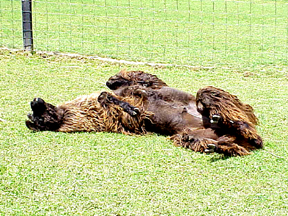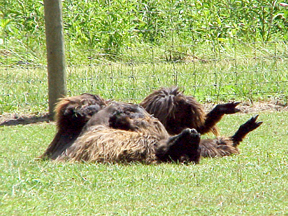|
Heat Stress!! Each year many llamas and alpacas suffer and die each year of heat stress! And definitely not just on the farms of new, un-experienced owners. Are your facilities prepared for summer heat and humidity?
With summer just around the corner, itís time we all give thought to our ďplan of attackĒ for getting our families of llamas safely through those extreme hot, humid days. Common sense tells us that a coat of heavy wool, along with times of prolonged high air temperatures, combined with high humidity, can be very conducive to elevated body temperatures. Combine this atmosphere with stresses such as limited air movement, late gestation, lactation, improper nutrition, or activity such as breeding, showing, or fence pacing from weaning, and we have conditions that are apt to cause body temperatures to elevate into the danger zone of heat stress. A formula, which has been helpful to llama breeders to determine when conditions are in the danger zone, is as follows: If the combined temperature and humidity equals a number of less than 110, it is not likely there will be a problem. If the temperature and humidity equals 150, it is time to show caution - no extra activity. If these combined numbers equal over 180, conditions are dangerous and all animals should be closely monitored.
Preventative management is the best tool in fighting heat stress. Numerous fans are at the top of the list. Fans, and yes, that is plural, should be placed so each and every animal has the opportunity to lay in a shaded area with good air movement blowing right on them. The Patton fans available at Wal Mart are good for taking to shows and to begin with. However, they donít last very long and will start to overheat. A fan from Granger with an enclosed motor moves alot of air and really hold up in the barn, but of course is more expensive. And the large 4í floor fans work extremely well - also somewhat expensive - and the llamas love to lay in front of them! Iíve also seen old furnace fans used and they move an incredible amount of air! A good plan might be to try to purchase just one good fan a year and keep adding. Fans should be at the top of your equipment list.
If youíre in the process of building a new barn or shelter, give serious consideration to the height of the roof as hot air always rises. The higher the roof, the more comfortable the animals will be on the ground. Vents along the peak of the roof allow the heat to escape. An addition of an exhaust fan (or fans on each end of the building) installed up in the gables of the barn will allow complete air exchange periodically.
Cool water should be available at all times and on hot days, an additional bucket of water with electrolytes added will help your animals fight the effects of the heat. Some breeders suggest even adding a little raspberry gelatin to the electrolyte water for an added flavored treat, but it is not necessary. It seems we all like these added little touches to pamper our animals. However, when offering electrolytes, it is important that you clean the bucket thoroughly each day as bacteria grows quickly in these conditions. Most llamas enjoy being sprayed on the legs, the belly, and the arm pits with water on days when temperatures rise to the extreme. Spraying on the inside of the back legs is especially beneficial. Some llamas enjoy this hosing so much, they are quite entertaining as they perform with their prancing, dancing, and twirling routines when it is their turn to be sprayed.
One of the most effective and important means of prevention is the shearing that you give each llama in the spring. There are a variety of styles for shearing so itís a matter of preference as to how you shear. Just make sure you open up their thermal window, the belly, and the arm pits as that is where they dissipate perspiration and heat. Having their fiber short allows them to perspire freely and sluff off some of the heat build up in the body. About an inch of fiber should be left so the llamaís skin will not sunburn. This remaining fiber also offers them some protection from alot of fly bites. And as long as youíre shearing, if youíre not going to use all that wool, donate it to one of the wool co-ops that are working so hard to promote the llama fiber industry.
Along with the shearing, I personally feel that an annual good grooming for each animal is beneficial for comfort in the heat and also a healthy skin. Unless youíre shearing the entire body, the remaining wool on the neck, chest, and legs can be matted and still prevent the skin from ďbreathingĒ and allowing the perspiration to evaporate. If only shearing in a show cut or a barrel cut, clean and separate the remaining fiber on his body and get rid of all that accumulated dead wool. This will give the llama air circulation to the skin. Heíll feel so much better.
Last, but definitely not least in the order of importance, is nutrition. Just because the pastures are green and growing, it is not recommended that we eliminate their normal llama feed and minerals routine. Good quality hay can even still be offered but just not in the same quantities as during the winter months. It is most important to keep them in top nutritional condition, and keep parasites in control, so they can successfully withstand the stresses of summer weather. And certainly you donít want to force them to go out in the pastures searching for food in the hottest part of the day.
Even with all these special precautions and top management, one of your animals may still show signs of heat stress. The key here is to make a rapid diagnosis and start immediate treatment. So, we need to be aware of what kind of signs to look for in heat stress. Each animal reacts differently and you know the individual mannerisms of each of your animals. If you suspect something is wrong, it probably is! The most common clinical sign is laying around - reluctant to move unless agitated. When checking on animals, itís a good idea to disturb them and make sure each one stands and walks normally. Along with being lethargic, you may observe frothing and drooling around the lips of an animal suffering from the heat. Possibly you will notice open mouth breathing. The animal in question will have an elevated body temperature, but maybe only 103 degrees. Each animal is different and they donít have to register a temperature of 106 degrees and up to be heat stressed. Drooping of the lower lip, in-coordination and staggering during movement, and stiffness are more serious signs. The heart beat may be elevated although respiration may be normal. Immediate attention is needed at this time to cool the animal down!
Cold water on the legs and the thermal window, as well as ice bags in the arm pits of the animal, will help to normalize the body temperature. Also provide good air flow to the thermal window. Banamine may be administered to address inflammation. Cold water enemas are not advised unless the body temperature is over 108 degrees since a cold water enema will make your rectal temperature readings invalid. Offer electrolytes (even Gatorade) or tube if necessary. If the animal is down, it is important to get veterinary attention as soon as possible. High body temperatures of 107 to 110 degrees for more than one or two hours may present complications
such as tissue damage, electrolyte imbalance, cerebral edema, or renal and liver damage. Pregnant females often abort in a couple of weeks or end up delivering cria that are three to five weeks early. Congenital birth defects are 10% more prevalent in crias born to females who have experienced days of elevated heat while in those most important first 50 days of gestation. Veterinary attention is most important to address dehydration, electrolyte imbalance, inflammation, and pain that results from neuromuscular tissue destruction. An intravenous catheter for treatment may be necessary along with a CBC and Chem panel. Daily physical therapy may also be required. It is recommended that a down llama be padded with at least one foot of deep straw or even a water bed mattress. During the day, the patient can be turned from side to side about every three hours and each leg worked for five minutes 3-4 times daily. This enhances circulation, helps prevent muscle contractions, and is more comfortable for painful tissues. Water therapy may also be helpful.
(Hints on how to make a
sling to elevate the down llama).
Heat stress is not a pleasant situation and unfortunately many times results in death. Your preparation, awareness, and management is the key!!
This article, written by Marilyn Nenni, appeared in the April 1998 Hoosier Hummer.
 |
 |
|
Even on the hottest
days, the llamas like to lay out and sun themselves. They
normally turn their belly towards the sun and just lay there as if
hypnotized without any movement at all. We've had people
driving by stop in to tell us there's a dead llama out in the
pasture. Actually, it's one of the first tricks
these llamas play on new owners. They won't respond to anything
until you walk right up to them - certain that something tragic has
happened. Then they slowly open an eye and look up at you, "did
you want something?" |
|